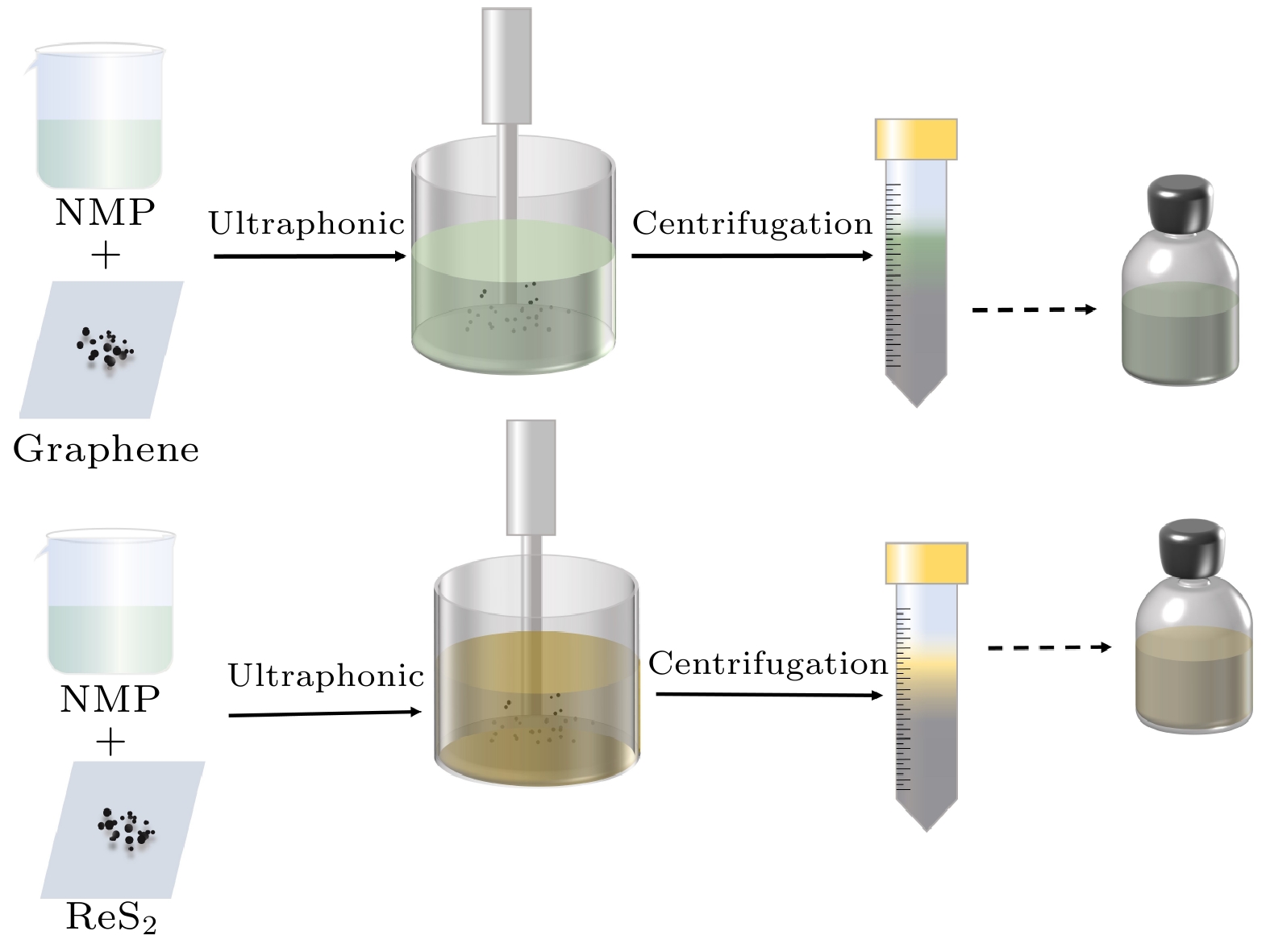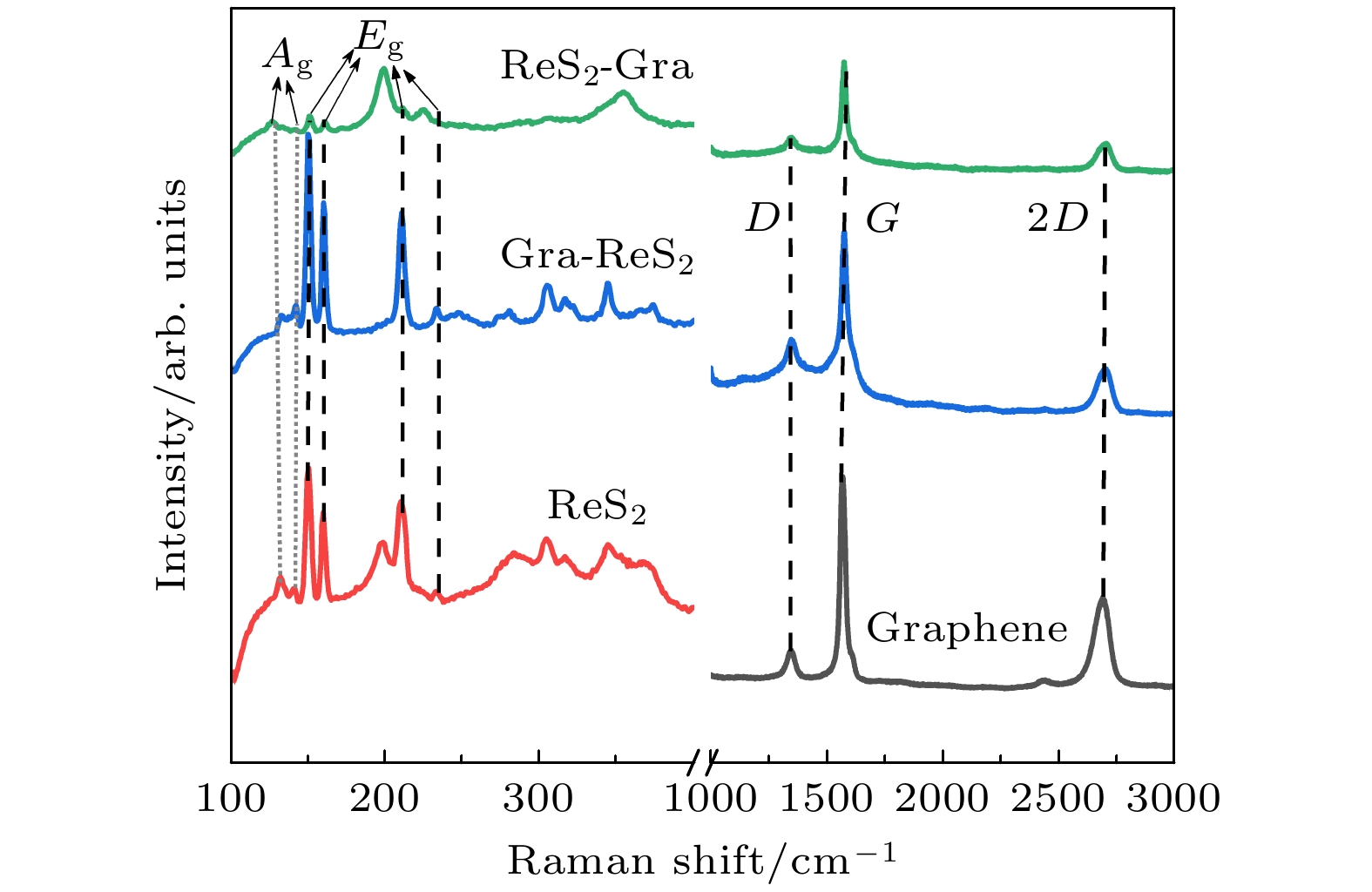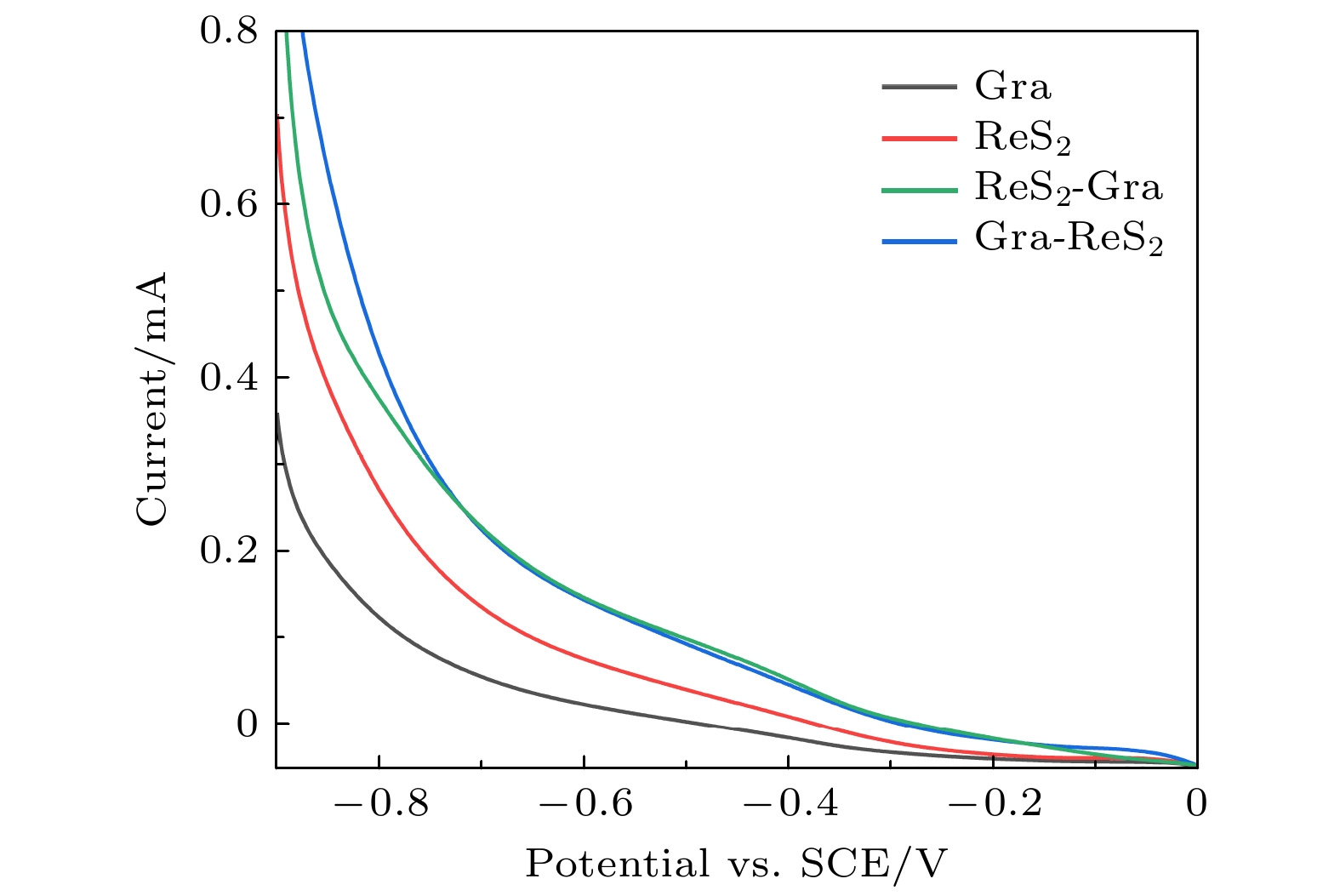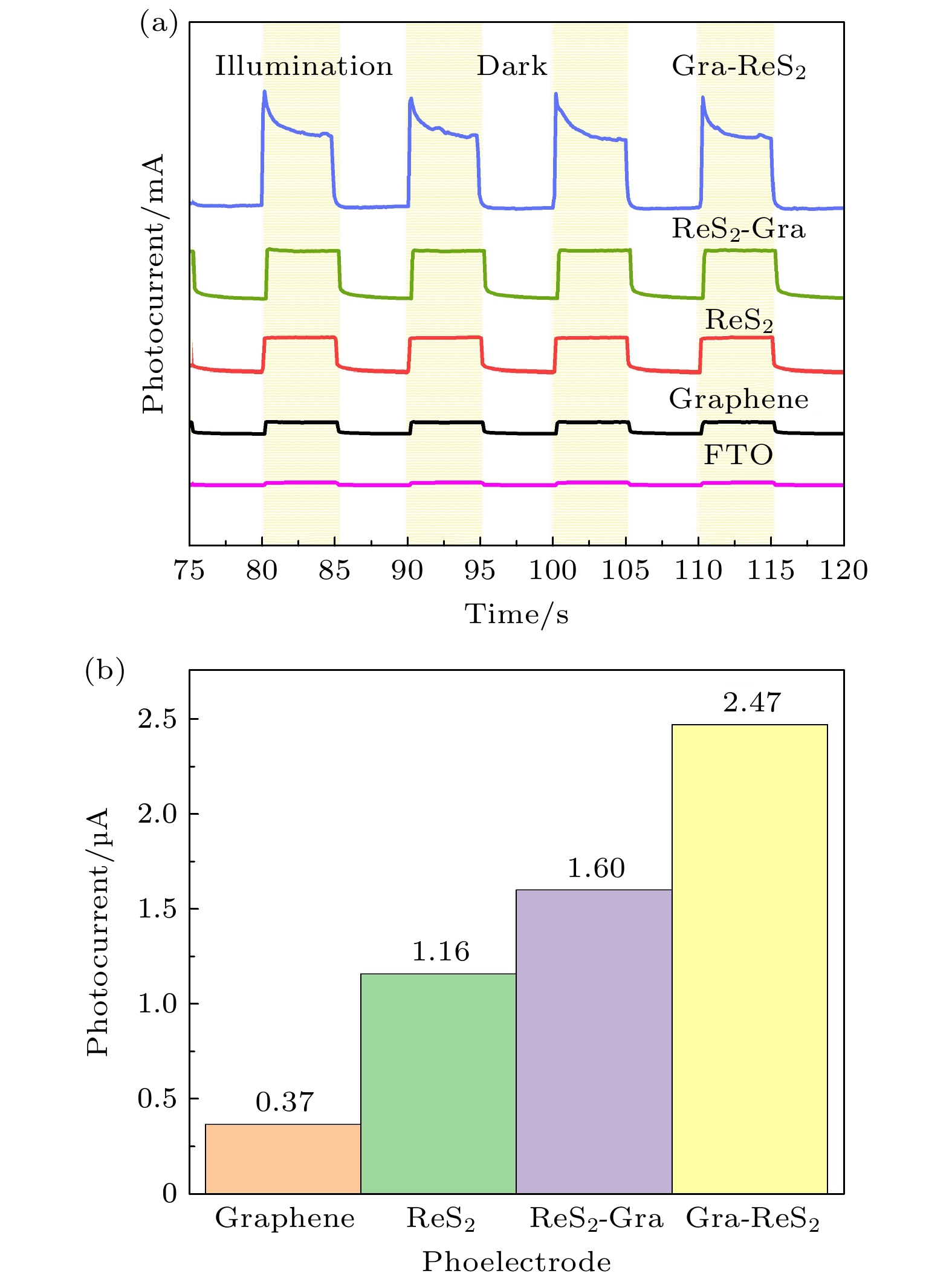-
能源及污染是新时代所面临的重要难题, 光催化技术可通过电解水产氢以及降解有机物污染物, 在一定程度上解决此问题. 而制备光催化活性较好、光生载流子分离效率高的光催化剂是这项技术的关键. 本文采用液相剥离法结合电泳沉积法制备得到具有不同堆垛结构的二硫化铼-石墨烯(ReS2-Gra, ReS2在上)与石墨烯-二硫化铼(Gra-ReS2, 石墨烯在上)范德瓦耳斯异质结薄膜, 并对其进行了光谱学表征. 将上述异质结作为光电极材料, 应用在光电化学反应中, 发现: 1) 不同的堆垛结构, 将影响异质结材料的光电化学特性, 即在相同条件下, 与ReS2-Gra光电极相比, Gra-ReS2光电极的光电流增大了54%; 2) 异质结的构建, 使得光电极材料的光电化学特性得到显著增强, 得到了更大且响应更迅速的光电流, 即Gra-ReS2光电极(2.47 μA)的光电流响应是纯ReS2光电极(1.16 μA)的2倍. 本工作为范德瓦耳斯异质结的制备提出新思路的同时, 也为太阳能转换器件的研究打下了理论基础.Energy and pollution are crucial problems. Photocatalysis technology is a way to solve the problem by electrolysis of aquatic hydrogen and degradation of organic pollutants. Preparing photocatalysts with fantastic photocatalytic activity and high photocarrier separation efficiency is a key technique. In recent years, two-dimensional (2D) nanomaterials have attracted much attention because of their unique structures and excellent properties, which are different from the traditional materials’. The 2D nanomaterials demonstrate in-plane covalent bonds and out-of-plane van der Waals interactions. Therefore, two 2D materials can form van der Waals heterojunctions by van der Waals forces, which are also known as nanocomposites. However, there is an interesting problem in the study of van der Waals heterojunctions in the field of photochemistry, which has not been paid attention to no studied. Specifically, that problem is whether the photochemical properties of the van der Waals heterojunctions are affected by the different stacking structures after the relationship between the upper and lower positions has been adjusted. In this paper, the van der Waals heterojunction films with different stacking structures ReS2-Gra (ReS2 on the top) and Gra-ReS2 (graphene on the top) are prepared by liquid phase exfoliation combined with electrophoretic deposition method. The heterojunctions are utilized as photoelectrodes in photochemical reactions, and the findings are as follows. i) Different stacking structures will affect the photoelectric chemical characteristics of heterojunctions: comparing with the ReS2-Gra photoelectrode, the photocurrent of the Gra-ReS2 photoelectrode increased by 54% under the same conditions. We think that the main reason is due to the fact that graphene has a zero-band gap structure and holds a wider spectral absorption range. ii) The construction of the heterojunction significantly enhances the photochemical properties of the photoelectrode materials, resulting in a larger and rapidly photocurrent response. The photocurrent response of the Gra-ReS2 photoelectrode (2.47 μA) is twice that of the pure ReS2 photoelectrode (1.16 μA). Based on the experimental results of this paper, a possible mechanism for effective separation and prolonged recombination of the photo-induced electro-hole pairs in ReS2/graphene heterojunction is proposed. This work not only puts forward new ideas for preparing the van der Waals heterojunctions, but also lays a theoretical foundation for further studying the solar energy conversion devices.
-
Keywords:
- van der Waals heterojunctions /
- ReS2 /
- graphene /
- photoelectrochemistry
[1] Liu Y, Huang Y, Duan X F 2019 Nature 567 323
 Google Scholar
Google Scholar
[2] Zhang Z, Lin P, Liao Q, Kang Z, Zhang Y 2019 Adv. Mater. 31 1806411
 Google Scholar
Google Scholar
[3] He M M, Quan C J, He C, Huang Y Y, Zhu L P, Yao Z H, Zhang S J, Bai J T, Xu X L 2017 J. Phys. Chem. C 121 27147
 Google Scholar
Google Scholar
[4] Quan C J, Lu C H, He C, Xu X, Huang Y Y, Zhao Q Y, Xu X L 2019 Adv. Mater. Interfaces 6 1801733
 Google Scholar
Google Scholar
[5] Zhang X Y, Selkirk A, Zhang S F, Huang J W, Li Y X, Xie Y F, Dong N N, Cui Y, Zhang L, Blau W J, Wang J 2017 Chem. Eur. J 23 3321
 Google Scholar
Google Scholar
[6] Pasqual R, Schaibley J R, Jones M A, Ross S J, Wu S F, Aivazian G, Klement P, Seyler K, Clark G, Ghimire N J, Yan J Q, Mandrus D G, Yao W, Xu X D 2015 Nat. Commun. 6 6242
 Google Scholar
Google Scholar
[7] Sun Y, Zhou Z S, Huang Z, Wu J B, Zhou L J, Cheng Y, Liu J Q, Zhu C, Liu K H, Wang X Y, Wang J P, Huang W, Wang L 2019 Adv. Mater. 31 1806562
 Google Scholar
Google Scholar
[8] 李亮, 皮乐晶, 李会巧, 翟天佑 2017 科学通报 62 3134
 Google Scholar
Google Scholar
Li L, Pi Y J, Li H Q, Zhai T Y, 2017 Chin. Sci. Bull. 62 3134
 Google Scholar
Google Scholar
[9] Huang M J, Zhou Y X, Guo Y H, Wang H, Hu X R, Xu X L, Ren Z Y 2018 J. Mater. Sci. 53 7744
 Google Scholar
Google Scholar
[10] Lu C H, Ma J Y, Si K Y, Xu X, Quan C J, He C, Xu X L 2019 Phys. Status Solidi A 216 1900544
 Google Scholar
Google Scholar
[11] Si K Y, Ma J Y, Lu C H, Zhou Y X, He C, Yang D, Wang X, Xu X L 2020 Appl. Surf. Sci. 507 145082
 Google Scholar
Google Scholar
[12] 徐铖, 彭涛, 管明艳, 张强, 马锡英 2019 苏州科技大学学报(自然科学版) 36 23
 Google Scholar
Google Scholar
Xu C, Peng T, Guan M Y, Zhang Q, Ma X Y 2019 J. Suzhou Univ. Sci. Technol. (Nat. Sci.) 36 23
 Google Scholar
Google Scholar
[13] Tiwari Santosh K, Sumanta S, Nannan W, Andrzej H 2019 J. Sci-Adv. Mater. Dev. 5 10
 Google Scholar
Google Scholar
[14] Thomas W R, Amir Y 2010 Nat. Nanotechnol. 5 699
 Google Scholar
Google Scholar
[15] Huimei L, Bo X, J-M L, Jiang Y, Feng M, Chun-Gang D, G W X 2016 Phys. Chem. Chem. Phys. 18 14222
 Google Scholar
Google Scholar
[16] 廖杨芳, 詹建友, 宋春红, 杨姗姗, 吕兵 2019 低温物理学报 41 191
 Google Scholar
Google Scholar
Liao Y F, Zhan J Y, Song C H, Yang S S, Lv B 2019 Low Temp. Phys. Lett. 41 191
 Google Scholar
Google Scholar
[17] Zhang Q, Wang W, Zhang J, Zhu X, Fu L 2018 Adv. Mater. 30 1707123
 Google Scholar
Google Scholar
[18] Wan X, Chen K, Liu D 2012 Chem. Mater. 24 3906
 Google Scholar
Google Scholar
[19] Zhai T, Li H, Gan L, Ma Y, Hafeez M 2016 Adv. Funct. Mater. 26 4551
 Google Scholar
Google Scholar
[20] Feng Y, Zhou W, Wang Y, Zhou J, Liu E, Fu Y, Ni Z, Wu X, Yuan H, Miao F 2015 Phys. Rev. B 92 054110
 Google Scholar
Google Scholar
[21] Liu H, Liu M, Tang R, Luo Z C, Xu W C, Luo A P, Wang F Z 2016 Opt. Eng. 55 081308
 Google Scholar
Google Scholar
[22] Guo Y H, Zhao Q Y, Yao Z H, Si K Y, Zhou Y X, Xu X L 2017 Nanotechnology 28 335602
 Google Scholar
Google Scholar
[23] Zhao Q, Guo Y, Zhou Y, Yan X, Xu X 2017 J. Colloid Interfaces Sci. 490 287
 Google Scholar
Google Scholar
[24] Li L Q, Long R, Prezhdo O V 2017 Chem. Mater. 29 2466
 Google Scholar
Google Scholar
[25] Long R, Prezhdo O V 2016 Nano Lett. 16 1996
 Google Scholar
Google Scholar
-
-
[1] Liu Y, Huang Y, Duan X F 2019 Nature 567 323
 Google Scholar
Google Scholar
[2] Zhang Z, Lin P, Liao Q, Kang Z, Zhang Y 2019 Adv. Mater. 31 1806411
 Google Scholar
Google Scholar
[3] He M M, Quan C J, He C, Huang Y Y, Zhu L P, Yao Z H, Zhang S J, Bai J T, Xu X L 2017 J. Phys. Chem. C 121 27147
 Google Scholar
Google Scholar
[4] Quan C J, Lu C H, He C, Xu X, Huang Y Y, Zhao Q Y, Xu X L 2019 Adv. Mater. Interfaces 6 1801733
 Google Scholar
Google Scholar
[5] Zhang X Y, Selkirk A, Zhang S F, Huang J W, Li Y X, Xie Y F, Dong N N, Cui Y, Zhang L, Blau W J, Wang J 2017 Chem. Eur. J 23 3321
 Google Scholar
Google Scholar
[6] Pasqual R, Schaibley J R, Jones M A, Ross S J, Wu S F, Aivazian G, Klement P, Seyler K, Clark G, Ghimire N J, Yan J Q, Mandrus D G, Yao W, Xu X D 2015 Nat. Commun. 6 6242
 Google Scholar
Google Scholar
[7] Sun Y, Zhou Z S, Huang Z, Wu J B, Zhou L J, Cheng Y, Liu J Q, Zhu C, Liu K H, Wang X Y, Wang J P, Huang W, Wang L 2019 Adv. Mater. 31 1806562
 Google Scholar
Google Scholar
[8] 李亮, 皮乐晶, 李会巧, 翟天佑 2017 科学通报 62 3134
 Google Scholar
Google Scholar
Li L, Pi Y J, Li H Q, Zhai T Y, 2017 Chin. Sci. Bull. 62 3134
 Google Scholar
Google Scholar
[9] Huang M J, Zhou Y X, Guo Y H, Wang H, Hu X R, Xu X L, Ren Z Y 2018 J. Mater. Sci. 53 7744
 Google Scholar
Google Scholar
[10] Lu C H, Ma J Y, Si K Y, Xu X, Quan C J, He C, Xu X L 2019 Phys. Status Solidi A 216 1900544
 Google Scholar
Google Scholar
[11] Si K Y, Ma J Y, Lu C H, Zhou Y X, He C, Yang D, Wang X, Xu X L 2020 Appl. Surf. Sci. 507 145082
 Google Scholar
Google Scholar
[12] 徐铖, 彭涛, 管明艳, 张强, 马锡英 2019 苏州科技大学学报(自然科学版) 36 23
 Google Scholar
Google Scholar
Xu C, Peng T, Guan M Y, Zhang Q, Ma X Y 2019 J. Suzhou Univ. Sci. Technol. (Nat. Sci.) 36 23
 Google Scholar
Google Scholar
[13] Tiwari Santosh K, Sumanta S, Nannan W, Andrzej H 2019 J. Sci-Adv. Mater. Dev. 5 10
 Google Scholar
Google Scholar
[14] Thomas W R, Amir Y 2010 Nat. Nanotechnol. 5 699
 Google Scholar
Google Scholar
[15] Huimei L, Bo X, J-M L, Jiang Y, Feng M, Chun-Gang D, G W X 2016 Phys. Chem. Chem. Phys. 18 14222
 Google Scholar
Google Scholar
[16] 廖杨芳, 詹建友, 宋春红, 杨姗姗, 吕兵 2019 低温物理学报 41 191
 Google Scholar
Google Scholar
Liao Y F, Zhan J Y, Song C H, Yang S S, Lv B 2019 Low Temp. Phys. Lett. 41 191
 Google Scholar
Google Scholar
[17] Zhang Q, Wang W, Zhang J, Zhu X, Fu L 2018 Adv. Mater. 30 1707123
 Google Scholar
Google Scholar
[18] Wan X, Chen K, Liu D 2012 Chem. Mater. 24 3906
 Google Scholar
Google Scholar
[19] Zhai T, Li H, Gan L, Ma Y, Hafeez M 2016 Adv. Funct. Mater. 26 4551
 Google Scholar
Google Scholar
[20] Feng Y, Zhou W, Wang Y, Zhou J, Liu E, Fu Y, Ni Z, Wu X, Yuan H, Miao F 2015 Phys. Rev. B 92 054110
 Google Scholar
Google Scholar
[21] Liu H, Liu M, Tang R, Luo Z C, Xu W C, Luo A P, Wang F Z 2016 Opt. Eng. 55 081308
 Google Scholar
Google Scholar
[22] Guo Y H, Zhao Q Y, Yao Z H, Si K Y, Zhou Y X, Xu X L 2017 Nanotechnology 28 335602
 Google Scholar
Google Scholar
[23] Zhao Q, Guo Y, Zhou Y, Yan X, Xu X 2017 J. Colloid Interfaces Sci. 490 287
 Google Scholar
Google Scholar
[24] Li L Q, Long R, Prezhdo O V 2017 Chem. Mater. 29 2466
 Google Scholar
Google Scholar
[25] Long R, Prezhdo O V 2016 Nano Lett. 16 1996
 Google Scholar
Google Scholar
计量
- 文章访问数: 10004
- PDF下载量: 183
- 被引次数: 0














 下载:
下载:






